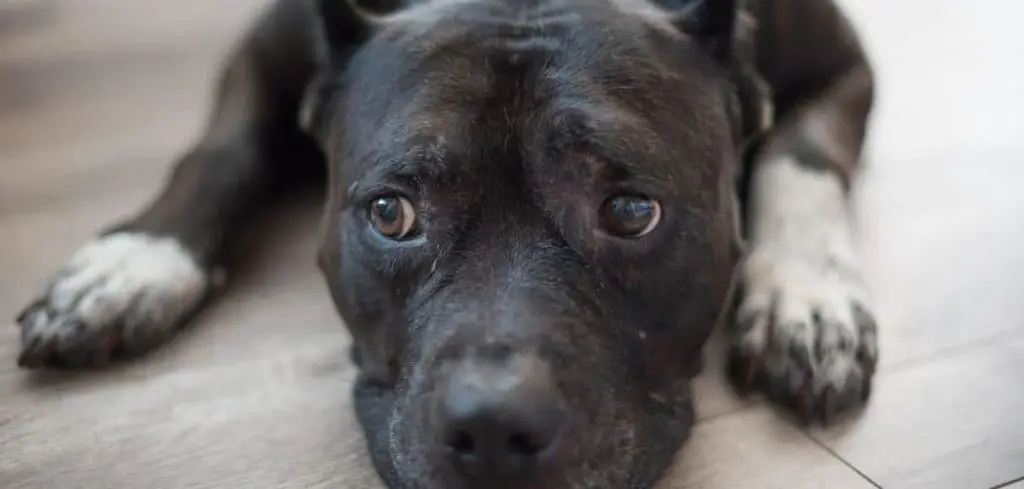Panting while moving around at night can be concerning for dog owners, as it may indicate discomfort, stress, or underlying medical issues. Observing your dog restlessly pacing, standing, or constantly adjusting positions while breathing heavily can signal that something is amiss.
We outline the common reasons why a dog may pant and move around at night, what you can do at home, and when to seek veterinary help.
Table of Contents
Dog Panting and Moving Around at Night — Why It Happens
When a dog pants and moves around at night, it’s often due to restlessness from pain, arthritis, or discomfort that becomes more noticeable when they’re trying to settle down. Anxiety and cognitive decline in older dogs can also cause nighttime pacing with panting.

Dog Panting and Moving Around at Night: Common Causes
Pain or Discomfort
Pain or physical discomfort is a frequent reason dogs pant and move around at night. Dogs experiencing arthritis, muscle soreness, or injuries often find it difficult to settle, and panting accompanies the discomfort.
Signs may include restlessness, whining, reluctance to lie down, or favoring a specific limb. Nighttime discomfort can worsen because dogs are less distracted than during the day.
Addressing pain with veterinary guidance, including medication or joint support, can improve your dog’s nighttime rest.
Read more: Dog Panting Excessively and Restlessness (Understand pacing behaviors)
Anxiety or Stress
Anxiety or emotional stress can manifest as panting and restless nighttime movement. Separation anxiety, changes in environment, or loud noises can make dogs feel unsettled, causing them to pace, pant, and occasionally whine.
Additional signs include trembling, drooling, or seeking reassurance from you. Creating a calming bedtime routine, using comforting bedding, and pheromone diffusers can help reduce anxiety, but persistent symptoms may require behavioral therapy or veterinary advice.
Cognitive Dysfunction (CDS)
Cognitive dysfunction, common in older dogs, can cause panting and nocturnal activity.
Similar to dementia in humans, CDS can lead to disorientation, restlessness, and pacing during the night.
You might notice confusion, forgetting house training, or vocalizing. Panting can be stress-related as the dog tries to self-soothe.
Early veterinary assessment can help manage symptoms through environmental enrichment, dietary supplements, or medications.
Heart or Respiratory Issues
Cardiac or respiratory problems can lead to panting and nighttime activity. Conditions like heart disease, congestive heart failure, or chronic bronchitis reduce oxygen delivery, causing the dog to pant and adjust positions to breathe more comfortably.
Other warning signs include coughing, lethargy during the day, fainting, or blue-tinged gums.
Prompt veterinary evaluation is crucial, as heart or lung issues can rapidly progress without treatment.
Painful Digestive Problems
Digestive discomfort may cause panting and restlessness at night. Gastrointestinal upset, constipation, or bloating can make lying down uncomfortable, resulting in pacing and heavy breathing.
Watch for vomiting, diarrhea, abdominal distension, or reluctance to eat. Treating the underlying digestive issue under veterinary supervision is essential to relieve discomfort and prevent complications like bloat, which can be life-threatening.
Neurological Conditions
Neurological disorders may trigger panting and nocturnal movement. Seizure activity, nerve pain, or spinal issues can cause involuntary movements, pacing, or restlessness at night.
Signs might include tremors, abnormal gait, disorientation, or sudden vocalizations. Early detection and management through veterinary care can prevent worsening symptoms and improve your dog’s quality of life.
Environmental or Lifestyle Factors
External factors such as temperature, bedding, or noise can contribute to panting and nighttime activity. Overheating, uncomfortable sleeping surfaces, or noisy surroundings may prevent your dog from settling comfortably.
Ensure a cool, quiet, and cozy sleeping area, and monitor for changes in activity patterns. Addressing environmental stressors can significantly reduce nighttime panting and movement.
What to Do If Your Dog Is Panting and Moving Around at Night
Provide a calm, comfortable sleeping environment. Reduce exposure to loud noises and ensure your dog has a cozy bed in a temperature-controlled area.
Establish a nighttime routine. Feeding, exercise, and bathroom breaks at consistent times can help signal to your dog that it’s time to rest.
Monitor and record episodes. Note the frequency, duration, triggers, and accompanying behaviors of panting and restlessness. This information is invaluable for veterinary assessment.
Address minor discomfort at home. Gentle massages, warm compresses, or supportive bedding may ease joint or muscle pain. Avoid forcing movement if your dog shows signs of distress.
Consult your veterinarian if panting and restlessness persist, worsen, or are accompanied by concerning symptoms. Follow any treatment plans, medications, or lifestyle recommendations closely.
When to Call or Visit Your Vet
Seek immediate veterinary care if your dog shows:
Persistent panting and restlessness that interferes with sleep
Signs of pain, severe discomfort, or sudden behavior changes
Weakness, fainting, or difficulty breathing
Vomiting, diarrhea, or abdominal swelling
Seizures, tremors, or uncoordinated movements
Timely evaluation helps address underlying conditions, prevent complications, and improve your dog’s overall comfort and quality of life.
Read more: Dog Panting and Licking Lips at Night (Why it happens)
Key Takeaway
Panting and moving around at night in dogs can stem from pain, anxiety, cognitive decline, heart or respiratory problems, digestive discomfort, neurological issues, or environmental factors.
Observing your dog, maintaining a calm environment, addressing potential triggers, and consulting a veterinarian are essential steps.
Early attention helps alleviate distress, prevent complications, and supports your dog’s nighttime comfort and overall well-being.
